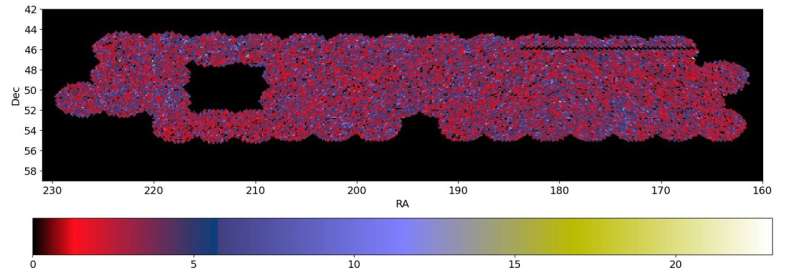LOFAR survey aids in study of clustering property of radio galaxies

A research team led by Dr. Zhao Gongbo from the National Astronomical Observatories of the Chinese Academy of Sciences (NAOC), in collaboration with scientists from the U.K. and Germany, investigated the large-scale structure distribution of radio galaxies observed by Low Frequency Array telescope (LOFAR), and determined the galaxy bias, which could help to better understand the clustering property of these galaxies.
These results were published in The Astrophysical Journal.
In the standard model of cosmology, the matter density of the universe is dominated by cold dark matter. The formation and evolution of galaxies occur inside these dark matter halos, and the mass and evolution of the host halo are correlated with the evolution and type of galaxy residing inside.
By using galaxy bias, the astronomers describe the relationship between the spatial distribution of galaxies and the underlying dark matter density field. Measuring the bias of radio galaxies can help us understand their formation and evolution history.
The LOFAR Two-meter Sky Survey (LoTSS) is an ongoing sensitive, high-resolution survey of the northern sky. This is a factor 10 more sensitive than the current best high-resolution sky survey, and will detect over 10 million radio sources, mostly star-forming galaxies but with a large proportion of active galactic nuclei (AGN).
Since the strongest radio sources are often optically faint or invisible, radio-loud AGNs are found to reside in more massive halos than optical AGNs. The radio surveys sample galaxies with higher bias as compared with optical observations, and thus complement existing and upcoming visible galaxy surveys. LoTSS provides a new perspective for studying the large-scale structure of the universe.
The research group systematically studied and processed LoTSS DR1's catalog, employed a proper flux cut and sky mask to ensure sample completeness, and finally selected over 100,000 sources for clustering analysis.
Unlike previous surveys, the LoTSS DR1 catalog contains a significant number of multi-component sources, and the researchers took this effect into account when interpreting the measured angular power spectrum.
Using the standard model of cosmology and employing the Monte Carlo Markov chain method, the research group obtained the constraints on the radio galaxy bias.
The results demonstrate that the LOFAR survey is suitable for cosmological studies. The upcoming data releases from LOFAR are expected to be deeper and wider, and will therefore provide improved cosmological measurements.
"This work helps understand the bias of LoTSS galaxy population and lays the foundation for future LoTSS DR2 analysis," said Dr. Prabhakar Tiwari, the first author of the study.
More information: Prabhakar Tiwari et al, Galaxy Power Spectrum and Biasing Results from the LOFAR Two-meter Sky Survey (First Data Release), The Astrophysical Journal (2022). DOI: 10.3847/1538-4357/ac5748
Provided by Chinese Academy of Sciences





















